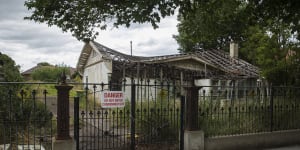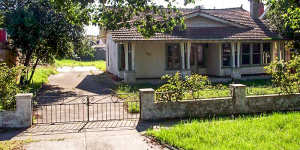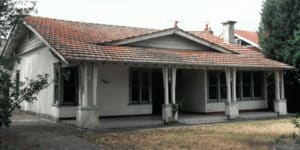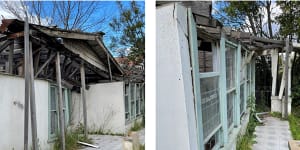The derelict house at 65 The Grove in Coburg will soon be cleared despite Moreland Council arguing that the decaying structure was a case of demolition of heritage “by neglect” that shouldn’t be rewarded.
The property was already in a state of disrepair when purchased by its current owners 20 years ago,and the Victorian Civil and Administrative Tribunal has now granted a permit to demolish it and build two new dwellings in its place.

The property,at 65 The Grove,in 2021 when council blocked demolitionPaul Jeffers
The so-called “Corkman laws”,introduced by the state government to stop developers illegally demolishing heritage buildings,were unable to protect the building because they were not yet part of Moreland’s planning rules.
Homes on The Grove,a grand,tree-lined street known as one of Coburg’s nicest,are covered by a heritage overlay,which means demolition can be refused if it adversely affects the area’s historical significance.
,despite council officers recommending they support the permit on the basis the home could no longer be restored.

The property prior to the removal of an internal structural wall and displacement of verandah pillars.Supplied
That decision followed an earlier refusal by Moreland in 2016,which was upheld on appeal in VCAT.
This time,however,VCAT has approved demolition,agreeing with the developers that the building was so badly damaged it would need to be rebuilt.
“[We] find that the contributory heritage fabric of the building has deteriorated beyond reasonable repair and what remains is of extremely low value,” the tribunal said.
The building was already unoccupied and dilapidated when it was purchased by James Poulakis,the founder of luxury department store Harrolds,in 2001.

The house in the mid 1990s.Supplied
However,its condition worsened in the intervening decades,the tribunal found,particularly when load-bearing walls,struts and beams were removed in 2014,causing the building’s roof to collapse.
“These elements did not fail of their own accord,but appear to have been cut and removed,” the tribunal found. “Some verandah posts were also removed,attributed ... as having been ‘vandalised’.”
A subsequent council order to make the building safe after the roof’s collapse led to the removal of its terracotta tiles and any weather protection.
Council’s experts argued the developer had wilfully neglected the building,contributing to its poor condition. However,the tribunal found those allegations were unsubstantiated.

Harrolds department store founder John Poulakis owns the property.Josh Robenstone
“While we do not condone any action that deliberately or wilfully destroys or adversely impacts on a heritage place,we cannot conclude on the material before us that the applicant has unlawfully demolished the building,” the tribunal found.
Poulakis said it was not financially viable to restore the building to the condition it was in when it was built more than 100 years ago.
“The cost just to bring it to a level of making it compliant was in excess of $2 million,then you have to start the cosmetics,” he toldThe Sunday Age.
“The previous owner had it assessed and it was derelict. There was nothing inside,no walls or nothing,it was skeletal.”

The damaged house.VCAT
Already a resident on The Grove,Poulakis said he was planning to build a house for his adult children once the block was cleared.
The tribunal found that his proposed replacement buildings would make a “positive contribution” to the area’s heritage.
Poulakis wouldn’t comment on how many bedrooms it would have,accept to say it would be a “big house”.
“I actually agree with the heritage overlay,but you can’t let stupidity rule when it becomes unviable to resurrect something that is not there,” he said.
Asked when demolition would take place,Poulakis said he still needed the final go-ahead from council.
“They’re not in any hurry,” he said. “We’ll have the bulldozers waiting.”
Last year, prohibiting development on sites where heritage buildings had been illegally demolished or allowed to fall into disrepair.
VCAT found those laws did not apply in the case of The Grove because they were not included in Moreland’s planning scheme at the time.
Moreland mayor Mark Riley said council was disappointed with the VCAT decision to approve demolition of a heritage property in an area of Coburg known for its historic homes.
“While it seems the newly introduced planning powers were just a little too late for this particular case,VCAT has identified how these stronger heritage protection powers can be beneficial into the future,” Riley said.
Greens councillor James Conlan,who moved the alternative motion to block the permit before it was appealed,said it was a “terrible decision” which highlighted the need for tougher rules.
“This type of wilful heritage destruction doesn’t happen in old,European cities,” he said.
“Because those cities have regulations that prevent demolition by neglect. Unfortunately,our planning rules actually incentivised this damaging behaviour.“
The Morning Edition newsletter is our guide to the day’s most important and interesting stories,analysis and insights..